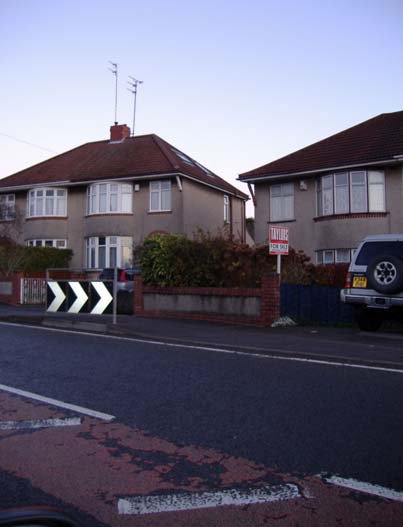
COLD
BCC 2-02
March 2007
HHSRS Feb/07
Yes
Yes
No
No
EXCESS
Vulnerable age
Related hazards
Persons aged 65 years or over
Excess Heat
Multiple locations
Secondary hazards
DESCRIPTION OF HAZARDS
Dwelling:
Two storey semi-detached house, circa 1936,
with attic bedroom
Front/Side Elevation View showing skylights
in the hip end
Background: This dwelling comprises of a ground floor and first floor with a converted attic space which
forms the main (largest) bedroom. On the ground floor are two rooms and a kitchen with three ooms and a
combined WC/bathroom on the first floor. The staircase to the attic bedroom is accessed from the first floor
landing and is separated from the same by a plasterboard and plaster skim timber stud partition wall,
complete with a door. The dwelling has insulated cavity walls, double glazed windows throughout (includingthe
skylight windows to the hip end of the attic bedroom) and full gas central heating, including a radiator in the
attic room. There is no insulation to the main roof, nor is there any insulation in the attic room floor cavity. The
roof covering itself is felted and in good repair.
LIST OF RELEVANT MATTERS
LIKELIHOOD & OUTCOMES
3
g
-
h
-
i
-
j
-
k
-
-
-
-
-
?
a
Thermal insulation
b
Dampness
c
Settling of insulation
d
Type of heating provision
e
Size of heating provision
f
Installation & maintenance
of heating provision
# Compounding matters
-
None
Key
3
Seriously defective
2
Defective
1
Not satisfactory
-
Satisfactory/NA
Controls to heating provision
Amount of ventilation
Ventilation controls
Disrepair to ventilation
Draughts
Justification
There is no reason to suppose that the spread of likely harm outcomes would be any different to the national
average.
Av. 1920-45 non-HMO:1,035
RATING
Score: 1,023
A B C D E
F G H
I
J
RATING SCORES AFTER IMPROVEMENT
IMPROVE
Likelihood to
1 in 1,800
Outcomes to
31.6 4.6 21.5 42.3
%
Justification
The provision of insulation between the roof rafters to meet current Building Regulation standards would
reduce the likelihood of an occurrence to well below the national average, particularly having regard to the
other existing heating and insulation measures present in the dwelling.
Av:1,035
Average likelihood, outcomes and HHSRS score for all persons aged 65 years and over,1997-
99.
NEW RATING
Av: Nos
Score: 181
A B C D E
F G H
I
J
BCC 2-02
March 2007
HEALTH AND SAFETY RATING SYSTEM SCORES
LIKELIHOOD
1 in 320
Low
High
Av 1920-45 Non-HMO: 340
< 4200 2400 1300 750 420 240 130
75
42
24
13
7.5
4
2.5
1.5 >
Justification
Compared to the average inter-war dwelling, the structure of the main part of the house is well insulated with
cavity wall insulation, and is also free from draughts (the double glazing). There is an effective and extensive
heating system which is capable of raising and maintaining adequate temperature. These factors would point
to the likelihood being less than average however the wholly uninsulated attic (with the possibility of some
draughts from the roof structure) will increase significantly the heat loss and it will be more difficult to maintain
a healthy room temperature in the attic bedroom. Such a situation is regarded as being worse than average
for this age and type of dwelling. It is also a semi-detached house with three exposed surfaces to the hipped
roof through which heat can be lost (compared to a mid-terraced house). The situation in the attic therefore
counters the other positive factors and the likelihood is assessed as being about average.
OUTCOMES
Class I
< 0.05
Class II
< 0.05
Class III
< 0.05
Class IV
< 0.05
%
Av 1920-45 Non HMO: 34.0
31.6
0.15 0.3
0.7
1.5
3
7
15
26
38 >
Av: 6.0
4.6
0.15 0.3
0.7
1.5
3
7
15
26
38 >
Av: 18.0
21.5
0.15 0.3
0.7
1.5
3
7
15
26
38 >
Av: 42.0
42.3
0.15 0.3
0.7
1.5
3
7
15
26
38 >